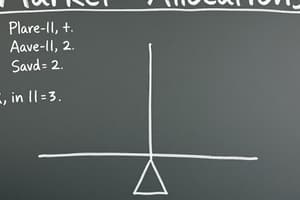Podcast
Questions and Answers
Which of the following is a key difference between the market and political sectors?
Which of the following is a key difference between the market and political sectors?
- There is a one-to-one link between payment for and receipt of a good in the political sector, but this is often not true in the market sector
- Government can use coercive force against adults to modify their behavior or force them to pay for a good or service (correct)
- Voters have a strong incentive to acquire information to make better decisions in the market sector
- Scarcity is a constraint in the market sector but not the political sector
In the market sector, which of the following is true about consumers' incentive to acquire information?
In the market sector, which of the following is true about consumers' incentive to acquire information?
- Consumers' incentive to acquire information is the same as in the political sector
- Consumers do not have much incentive to acquire information (correct)
- Consumers have a strong incentive to acquire information that will help them make better decisions
- Consumers' incentive to acquire information is not a relevant factor in the market sector
Which of the following is a key characteristic of government that differentiates it from private firms?
Which of the following is a key characteristic of government that differentiates it from private firms?
- Government can escape the constraints imposed by scarcity
- Government can direct resources in a manner that serves the private interest of individuals
- Government can use coercive force against adults to modify their behavior or force them to pay for a good or service (correct)
- Government can produce goods and services that people value
Which of the following is a key difference between the market and political sectors in terms of the link between payment and receipt of a good?
Which of the following is a key difference between the market and political sectors in terms of the link between payment and receipt of a good?
Which of the following is a key constraint present in the market sector but not the political sector?
Which of the following is a key constraint present in the market sector but not the political sector?
In the political sector, which of the following is true about voters' incentive to acquire information?
In the political sector, which of the following is true about voters' incentive to acquire information?
According to public choice theory, what is the primary motivation for politicians when enacting policies?
According to public choice theory, what is the primary motivation for politicians when enacting policies?
Which of the following statements about public choice analysis is true?
Which of the following statements about public choice analysis is true?
According to public choice theory, which of the following is most likely to be supported by a voter?
According to public choice theory, which of the following is most likely to be supported by a voter?
When the tax to fund a government project is allocated among voters in proportion to the benefits they receive, which of the following is most likely to occur?
When the tax to fund a government project is allocated among voters in proportion to the benefits they receive, which of the following is most likely to occur?
In which case is the political process most likely to result in the acceptance of efficient projects and rejection of inefficient projects?
In which case is the political process most likely to result in the acceptance of efficient projects and rejection of inefficient projects?
Which of the following statements regarding the political process is true?
Which of the following statements regarding the political process is true?
Study Notes
Market Allocation vs Political Process
- Market allocation and political process differ in the presence of competition, scarcity constraint, and one-to-one link between payment and receipt of goods.
- In the market sector, competition exists, scarcity is a constraint, and there is a direct link between payment and receipt of goods.
- In the political sector, competition is absent, scarcity is not a constraint, and there is no direct link between payment and receipt of goods.
Characteristics of Government
- Government's distinguishing characteristic is its ability to use coercive force and direct resources in the public interest.
- Government can produce goods and services that people value, and escape scarcity constraints.
Political Process and Public Choice
- Politicians must try to enact policies that gain votes and support from contributors to remain in office.
- Public choice analysis studies decision-making in the public sector, assuming individuals seek personal interests rather than the public interest.
- Public choice theory finds that individuals managing government agencies have a weaker incentive to be efficient than those in private businesses.
Public Choice Analysis
- Public choice analysis develops a logically consistent theory based on individual actors responding to incentives.
- It assumes individuals react to incentives in the private sector, but not in the public sector.
Efficient Projects and Public Choice
- When benefits are concentrated and costs are widespread, productive projects are more likely to be rejected by voters.
- When costs are concentrated and benefits are widespread, productive projects are more likely to be accepted by voters.
- When both benefits and costs are widespread, project acceptance is uncertain.
Agricultural Interests and Lobbying
- Agricultural interests lobby for higher farm subsidies and price supports because they benefit from the programs, not because of food shortage concerns.
Studying That Suits You
Use AI to generate personalized quizzes and flashcards to suit your learning preferences.
Description
Explore the differences between market allocation and the political process through this quiz. Learn about competition, scarcity, and payment-receipt link in both sectors, along with the incentives for acquiring information in the political sector.




